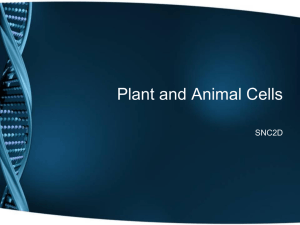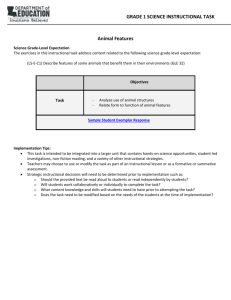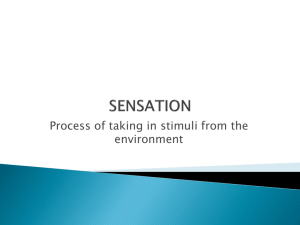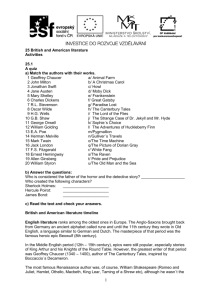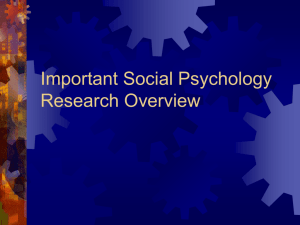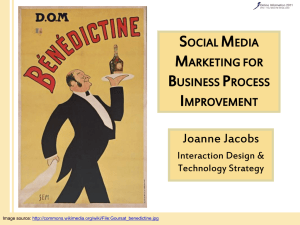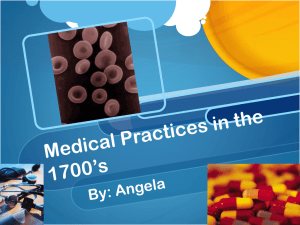Adaptation via Natural Selection Lesson Plan
advertisement
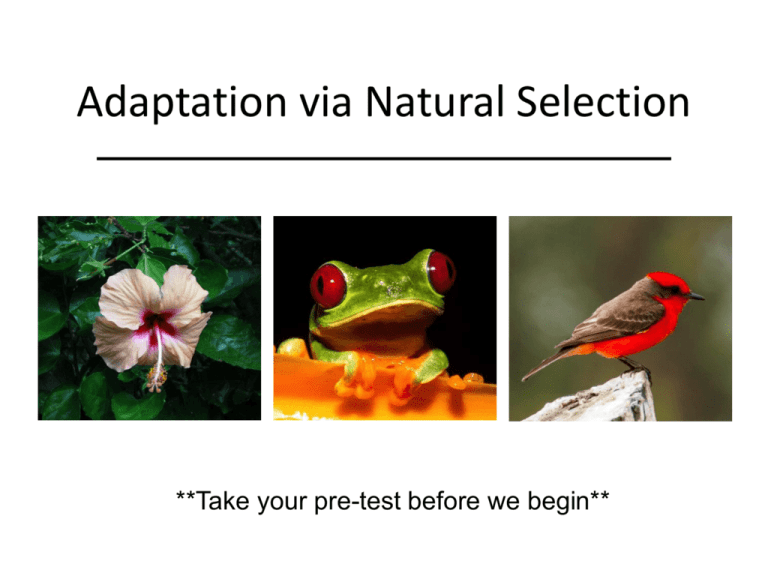
Adaptation via Natural Selection **Take your pre-test before we begin** How is a trait passed to an organism's offspring? Is having a long neck good or bad? Talk time A pregnant giraffe stretches her long neck to reach the green leaves of a tree. When the baby grows up, will it have a longer neck because its mother stretched so much? Talk Time Imagine two pairs of giraffes: 1. A male and female that only eat from the tops of tall trees. 2. A male and female that only eat from lower branches. If each pair has a baby giraffe, which baby will have a longer neck? Questions (answer one individually in worksheet) 1. How did giraffes get such a long neck? 2. Will giraffe babies be similar to their parents? Why? 3. How are traits, such as a long neck, passed from parents to offspring? Talk Time How might these ideas apply to birds with beaks of different sizes and shapes? Activity Time If using the peppered moth activity, skip the next slide! Explore Rice Hunting Activity Follow the directions Don’t forget: repeat with each paper color 3x Record in your worksheets Talk Time 1. What changes did you observe in the rice or moth population? Why did this happen? 2. What would happen if we colored the rice or moths to be more camouflaged? In the wild, would the next generation change color too? Listen and Talk • Discuss Lamarck’s and Darwin's ideas. Which theory drives the appearance of adaptations? 1. If no dark morph had existed in the rice or moths, what could have happened? 2. If more changes affected one population of rice or moths over time, might they become different enough to be a new species? Talk Time Weismann cut the tails off of many generations of mice, bred them, and observed what their offspring looked like. What do you think he found? Does this support Lamarck or Darwin’s ideas? 1. 2. 3. 4. 5. Talk Time How can a trait benefit an individual? What does "survival of the fittest" mean? How does an adaptation begin? How does a trait spread within a population? What factors might cause some animals to survive while others don't? Talk and Listen Define: 1. 2. 3. 4. 5. Fitness Adaptation Natural selection Heritability Mutation Talk and Listen 1. How do these ideas apply to other examples of adaptations? (Bird feet, cacti, and insect pests?) 2. What are some human adaptations and how do they increase our reproductive success (fitness) in the context of our habitat? Last Steps • Take post-test (says POST in upper left corner) • Discuss potential homework extension Image Credits Slide 1: Hibiscus by Forest & Kim Starr (https://commons.wikimedia.org/wiki/File:Starr_050107-2956_Hibiscus_rosa-sinensis.jpg) Red-eyed treefrog by Brian Gratwicke (https://commons.wikimedia.org/wiki/File:Red-eyed_Treefrog_(Agalychnis_callidryas).jpg) Vermillion flycatcher by James Diedrick (https://commons.wikimedia.org/wiki/File:Vermillion_Flycatcher.jpg) Slide 2: "Giraffe interaction" by Hein waschefort - Own work. Licensed under CC BY-SA 3.0 via Wikimedia Commons https://commons.wikimedia.org/wiki/File:Giraffe_interaction.jpg#/media/File:Giraffe_interaction.jpg Slide 3: Giraffe feeding by Muhammad Mahdi Karim (www.micro2macro.net) https://commons.wikimedia.org/wiki/File:Giraffe_feeding,_Tanzania_crop.jpg Slide 4: Baby giraffe by Ltshears (https://commons.wikimedia.org/wiki/File:BabyMasaiGiraffe1.jpg) Slide 5: "Flickr - Rainbirder - High-rise living" by Steve Garvie from Dunfermline, Fife, Scotland - High-rise living. Licensed under CC BY-SA 2.0 via Wikimedia Commons - https://commons.wikimedia.org/wiki/File:Flickr_-_Rainbirder_-_High-rise_living.jpg#/media/File:Flickr_-_Rainbirder_-_High-rise_living.jpg Slide 6: Bird beak diagram modified from Shyamal (original) and Jeff Dahl. (https://commons.wikimedia.org/wiki/File:BirdBeaks_named.svg) Slide 7: Computer (https://commons.wikimedia.org/wiki/File:Computer-aj_aj_ashton_01.svg) Slide 9: Biston betularia by Gilles San Martin (https://commons.wikimedia.org/wiki/File:Biston_betularia_20110529_102239_8073M.JPG) Slide 10: Both Biston betularia by Jerzy Strzelecki (https://commons.wikimedia.org/wiki/File:Biston_betularia(js)02_Lodz(Poland).jpg) (https://commons.wikimedia.org/wiki/File:Biston_betularia(js)01_Lodz(Poland).jpg) Image Credits (Continued) Slide 11: Rat line drawing by Gwilz (https://commons.wikimedia.org/wiki/File:Vector_diagram_of_laboratory_mouse_(black_and_white).svg) Slide 12: "Phlogophora meticulosa, Achateule 1" by Böhringer Friedrich - Own work. Licensed under CC BY-SA 2.5 via Wikimedia Commons – (https://commons.wikimedia.org/wiki/File:Phlogophora_meticulosa,_Achateule_1.JPG#/media/File:Phlogophora_meticulosa,_Achateule_1.JPG) "Fjellrev pho" by Mr. Per Harald Olsen – User Perhols on no.wikipedia - no.wikipedia. Licensed under CC BY-SA 3.0 via Wikimedia Commons – (https://commons.wikimedia.org/wiki/File:Fjellrev_pho.jpg#/media/File:Fjellrev_pho.jpg) Slide 13: Golden retriever puppes by Koosg. (https://commons.wikimedia.org/wiki/File:Golden_retriever_puppies_4_wk.jpg) Purple Honeycreeper by Gregory “Slobirdr” Smith (https://commons.wikimedia.org/wiki/File:Purple_Honeycreeper_(Cyanerpes_caeruleus)_(13962727398).jpg) "Rico - Albino Alligator" by Sherrif2966 - Own work. Licensed under CC BY-SA 4.0 via Wikimedia Commons - https://commons.wikimedia.org/wiki/File:Rico__Albino_Alligator.jpg#/media/File:Rico_-_Albino_Alligator.jpg Slide 14: Clawed feet: "Circaetus gallicus claw" by Original uploader was Emlok at pl.wikipedia - Originally from pl.wikipedia; description page is/was here.. Licensed under CC BY-SA 3.0 via Wikimedia Commons https://commons.wikimedia.org/wiki/File:Circaetus_gallicus_claw.jpg#/media/File:Circaetus_gallicus_claw.jpg Webbed foot and Colorado Potato beetle under public domain. Pincushion cactus: (https://commons.wikimedia.org/wiki/File:Siler_pincushion_cactus_(Pediocactus_sileri)_(6307401470).jpg) by USFWS Mountain-Prairie Slide 15: Gecko by FraKctured (https://commons.wikimedia.org/wiki/File:Gecko_regenerating_tail.jpg) Common Misconceptions • Natural resources are not limited • Organisms do not compete to survive/reproduce; or if there is competition, the strongest always survives • There is no variation within a population; or if there is, it does not affect survival • When a trait is no longer beneficial, it will disappear • Traits acquired during lifetime will be inherited by offspring • Traits that are positively influenced by the environment will be passed on to offspring • Fitness = strength, speed, intelligence or longevity, and it is not environment (context)-dependent • Mutations occur to meet the needs of the population, and change entire population equally • Organisms can intentionally become a new species • Mutations are adaptive/intentional responses to the environment Concept inventory from Anderson et al., JRST, 2002
